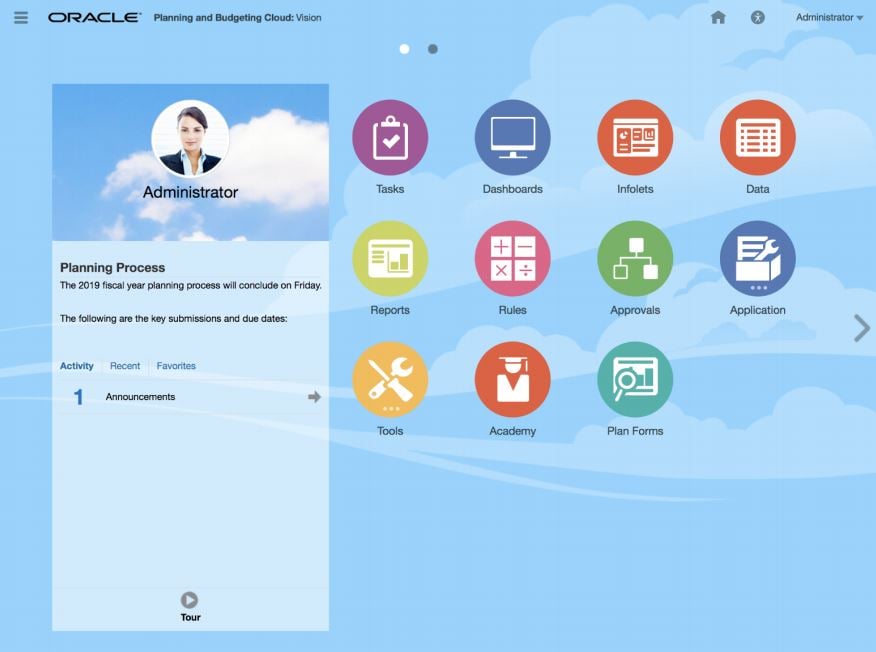The July updates for Account Reconciliations in Oracle EPM Cloud are here. This is the first set up updates since Oracle changed the structure of the EPM Cloud and pricing plans. In this blog post, we’ll cover enhancements to reconciliation attachments, the new version of EPM Automate, and more.
We’ll let you know any time there are updates to ARCS or any other Oracle EPM cloud products. Check the US-Analytics Oracle EPM & BI Blog every month.
The monthly update for Oracle ARCS will occur on Friday, July 19 during your normal daily maintenance window.
ARCS New Features
Enhancements to Reconciliation Attachments
New enhancements to Reconciliation attachments to make your work easier include:
- Attachments that apply to more than one period of a reconciliation can now be “carried forward” and will appear when the next reconciliation is created.
- Improved oversight of attachments since you can now view who first added the attachment and when it was added.
- Easier to view attachments by adding an “expand all” option for the attachments drawer. This option can be set as the default choice for that drawer.
Add or Remove Users When Working with Teams Using REST API
You can now add or remove a batch of users when working with teams using REST API.
New Version of EPM Automate
A new version of EPM Automate is available with this update. These new commands are now available:
exportAppSecurity and exportAppAudit
- exportAppAudit Command
This command exports data audit records into a ZIP file, which you can download for local storage. - exportAppSecurity Command
This command exports the date related to artifact-level access assignments (ACLs) to a ZIP file, which
you can download for local storage.
Changes to Provisioning Terminology
With a view to standardizing the terminology around assigning roles to users at the identity domain,
application, and artifact levels, EPM Cloud has changed such labels in the user interface to "Assign". Because of this change, the labels of Provision Roles tab and Provisioning Reports tab in Access Control have been renamed to Assign Roles and Role Assignment Report respectively. Similar changes have been made to the access control screens displayed in business processes and EPM Connections.
Removal of Support for Transport Layer Security Protocol 1.0 and 1.1
As announced in previous readiness documents, Oracle supports only Transport Layer Security protocol
version 1.2 (TLS 1.2) to communicate with EPM Cloud. To ensure the highest level of authentication and data
encryption security, support for TLS 1.0 and TLS 1.1 have been removed.
Because most modern operating systems and browsers support TLS 1.2; users of such systems and browsers are not affected by the deprecation of TLS 1.0 and 1.1.
You cannot use client operating systems that do not support TLS 1.2 (for example, Red Hat Enterprise Linux 5 and Microsoft Windows 2002) to run operating system-specific commands (for example, code to run cURL tools to transfer data and custom code that integrates with the REST APIs) against EPM Cloud. Additionally, Smart View and EPM Automate installed on such systems will also fail to communicate with EPM Cloud. Similarly, you cannot use browsers that do not support TLS 1.2 protocol to access EPM Cloud environments.
New EPM Cloud Features Tool
Oracle has released an EPM Cloud Features tool. Use this tool to quickly find features released each month
for your EPM Cloud business process. Click a link to learn more about each feature in the What’s New
document and the EPM Cloud user assistance.
Upcoming Changes
EPM Cloud's New Look and Feel
In a future update, there will be a revised interface with enhanced navigation and a new theme called Sky Blue.

The revised interface retains existing functionality and enhances your Home page experience with a more responsive design. The Welcome panel and the global header readjust after resizing, which means less scrolling. Clearer announcements and notification areas are added to the Welcome panel, as are arrows to help you navigate easily between the Home page and your infolets. A bigger Navigator menu has improved usability, more themes for customization are included, and a bigger work area has more space to maneuver and provide better visibility. The interface is more consistent with other Oracle products, such as Fusion Applications.
After the interface is released, all new customers will use the new lighter-colored Sky Blue theme, and existing customers will keep their current theme. You can switch themes using Tools, and then Appearance.
Removal of Instance Name from Predefined Role Names
Currently, the predefined role names displayed in the Access Control screens of EPM Cloud environments
prefix the instance name to the role name in INSTANCE_NAME ROLE_NAME format. They are also stored in this format in the snapshots, making it difficult to migrate snapshots from one instance to another.
To facilitate the migration of security across EPM Cloud environments, Oracle plans to rename predefined role names displayed within EPM Cloud applications by removing the instance name prefix in the August update. For example, if the instance name is Planning1, predefined role names are Planning1 Service Administrator, Planning1 Power User, Planning1 User and Planning1 Viewer. The new role names will be Service Administrator, Power User, User, and Viewer.
NOTE: This change does not affect how the role names are displayed in the MyServices customer portal.
This change will affect customers who use the predefined roles for managing application-level provisioning and access to artifacts; you will need to reassign such assignments using the updated role name after the roles are renamed. This change makes it easy to migrate EPM Cloud artifacts across environments.
Additionally, all predefined role names; Domain Administrator, Service Administrator, Power User,User, and Viewer will be treated as EPM Cloud keywords, which should not be used in the name of any custom artifacts that you create; for example, group name in Access Control. If you have any group with these keywords, rename them before this change comes into effect.
Considerations
Academy
In the Academy, some pages and icons may appear different in the video and the Cloud service.
Using Refresh
It is a best practice to use Refresh within the Account Reconciliation Cloud user interface rather than
performing a browser refresh.






